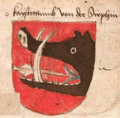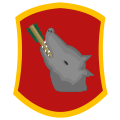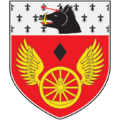
The coat of arms of Triballia (Serbian: Грб Трибалије / Grb Tribalije or Грб Тривалије / Grb Trivalije) is a historical coat of arms attributed to medieval Serbia by various armorials, and is today depicted in several Serbian municipality coat of arms in Šumadija. The motif is of a severed (erased) wild boar's head with an arrow in its mouth or through its head.
The Triballi were an ancient tribe whose name was used as an exonym for the Serbs by archaizing Byzantine authors in the Middle Ages.[1] The Triballian coat of arms depicts the head of a boar pierced by an arrow.[2] In the Chronicle of the Council of Constance from 1415, the motif is used as the coat of arms of the Serbian Despotate and is recalled in one of Stefan Lazarević's personal seals.[citation needed] It was used for historical Serbia in numerous armorials dating between the 15th and 18th centuries. The Habsburg monarchy adopted it into their flag of Serbia (as claimants), one of the flags given to an honorary flag-bearer during the coronation of the Hungarian king, since 1563. It was adopted by Karađorđe[3] into the seal of the Revolutionary Serbian government, alongside the Serbian cross.[4]
Gallery
Historical
-
Serbian emperor, Prussian ed. Chronicle of the Council of Constance (before 1437)
-
Serbia, later ed. Chronicle of the Council of Constance (1483)
-
Coats of arms of the Turkish Empire, Constantinople, Palaeologus, Byzantium and Serbia (1483), Conrad Grünenberg.
-
Serbia (Triballia), Wernigeroder Schaffhausensches Wappenbuch (between 1486 and 1492)
-
Serbia (Triballia) coat of arms, Cathedral of St. Elizabeth (built between 1378 and 1508)
-
Serbia, by Johann von Francolin (ca. 1565)
-
Banner of Bosnia–Serbia–Bulgaria–Wallachia at the funeral of Ferdinand I (1566)
-
Serbian emperor, by Christoph Silberysen (1576)
-
Serbia, by Martin Schrott (ca. 1580)
-
Unnamed, by Jerome de Bar (1604)
-
Sketch of flag of Serbia used at the coronation of Ferdinand II (1618).
-
Coat of arms of Kingdom of Serbia at Belgrade fortress (1717)
-
Coat of arms of the Kingdom of Serbia (1720)
-
Coat of arms of the Kingdom of Serbia
-
"Allegorical representation of Transylvania and Serbia" (1723), Altomonte
-
Triballian coat of arms, Stemmatographia (1741)
-
Emperor Dušan with coats of arms of Serbian lands (ca. 1750), Jov Vasiljevič, National Museum of Serbia
-
"Liberated Serbia" (1800s), Johann Georg Mansfeld
-
Sketch of flag of Serbia used at the coronation of Leopold II (1790)
-
Serbian uprising flag with the Triballi coat of arms (1804), Belgrade Military Museum
-
Serbian uprising flag with the Triballi coat of arms (1804), Loznica
-
Government seal during the First Serbian Uprising (1804)
-
Government seal during the First Serbian Uprising (1804), Takovo
-
Coat of arms of Kingdom of Serbia in the coat of arms of Hungary (1849)
-
Funeral procession for Albert VII, Archduke of Austria with the coat of arms of Kingdom of Serbia (1623)
Current
Municipalities in Serbia
-
Greater coat of arms of Barajevo
-
Lesser coat of arms of Barajevo
-
Greater coat of arms of Velika Plana
-
Lesser coat of arms of Velika Plana
-
Greater coat of arms of Kragujevac
-
Lesser coat of arms of Kragujevac
-
Greater coat of arms of Voždovac
-
Lesser coat of arms of Voždovac
-
Greater coat of arms of Lajkovac
-
Lesser coat of arms of Lajkovac
-
Greater coat of arms of Lapovo
-
Greater coat of arms of Topola
See also
References
- ^ Papazoglu 1978, p. 9.
- ^ Danko Popović; Dinko Davidov (2004). Studije o srpskoj umetnosti XVIII veka. Српска књижевна задруга. p. 18. ISBN 9788637908685.
- ^ Vanja Kraut; Miodrag Đorđević; Rade Rančić (1985). Istorija srpske grafike od XV do XX veka. Narodni muzej. p. 73. ISBN 9788636700013.
- ^ SANU (1957). Posebna izdanja. SANU. p. 130.
Sources
- Dragomir M. Acović (2008). Heraldika i Srbi. Zavod za udžbenike. ISBN 978-86-17-15093-6.
- Aleksandar Palavestra (2010). Илирски грбовници и други хералдички радови. Завод за уџбенике. ISBN 978-86-17-17266-2.
- Papazoglu, Fanula (1978). The Central Balkan Tribes in pre-Roman Times: Triballi, Autariatae, Dardanians, Scordisci and Moesians. Amsterdam: Hakkert. ISBN 9789025607937.





































